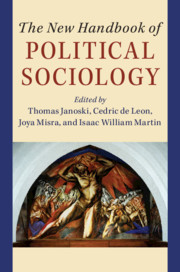Book contents
- The New Handbook of Political Sociology
- The New Handbook of Political Sociology
- Copyright page
- Dedication
- Contents
- Tables
- Figures
- Contributors
- Acknowledgments
- Introduction
- I Theories of Political Sociology
- II Media Explosion, Knowledge as Power, and Demographic Reversals
- 10 “Old” Media, “New” Media, Hybrid Media, and the Changing Character of Political Participation
- 11 The Sociology of Official Information Gathering
- 12 The Dark and Light Sides of Big Data
- 13 States, Parties, and Expertise
- 14 Toward a Political Sociology of Demography
- III The State and Its Political Organizations
- IV Civil Society: The Roots and Processes of Political Action
- V Established and New State Policies and Innovations
- VI Globalization and New and Bigger Sources of Power and Resistance
- Index
- References
14 - Toward a Political Sociology of Demography
from II - Media Explosion, Knowledge as Power, and Demographic Reversals
Published online by Cambridge University Press: 22 February 2020
- The New Handbook of Political Sociology
- The New Handbook of Political Sociology
- Copyright page
- Dedication
- Contents
- Tables
- Figures
- Contributors
- Acknowledgments
- Introduction
- I Theories of Political Sociology
- II Media Explosion, Knowledge as Power, and Demographic Reversals
- 10 “Old” Media, “New” Media, Hybrid Media, and the Changing Character of Political Participation
- 11 The Sociology of Official Information Gathering
- 12 The Dark and Light Sides of Big Data
- 13 States, Parties, and Expertise
- 14 Toward a Political Sociology of Demography
- III The State and Its Political Organizations
- IV Civil Society: The Roots and Processes of Political Action
- V Established and New State Policies and Innovations
- VI Globalization and New and Bigger Sources of Power and Resistance
- Index
- References
Summary
As of yet, there is no political sociology of demography. Although not entirely ignored, demography has not been a central concern or preoccupation for most political sociologists; other topics and themes have more forcefully commanded attention. With some important exceptions, its relationship to states, parties, and movements has rarely been explicitly foregrounded. The same can be said about the relationship between demography and power. But what would a political sociology of demography look like? What kinds of questions and issues could it address? How could it contribute to our understanding of politics and demography, and of the relationship between the two?
Keywords
- Type
- Chapter
- Information
- The New Handbook of Political Sociology , pp. 384 - 406Publisher: Cambridge University PressPrint publication year: 2020
References
- 1
- Cited by

